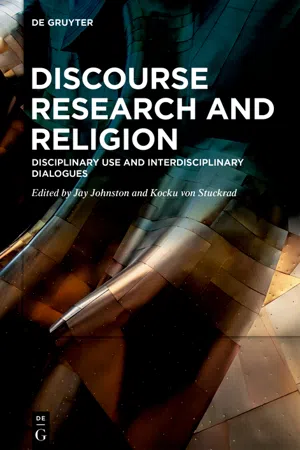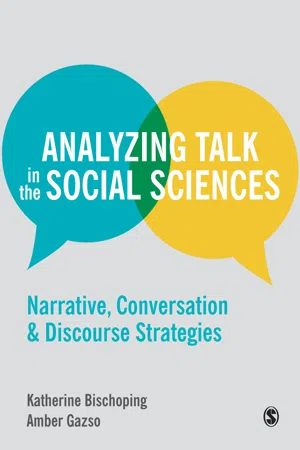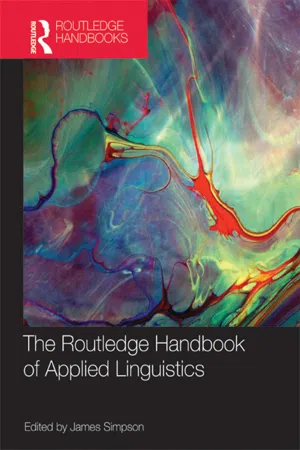Languages & Linguistics
Norman Fairclough
Norman Fairclough is a prominent British linguist known for his work in critical discourse analysis (CDA). He has contributed significantly to the study of language and power, emphasizing the role of language in shaping social relations and ideologies. Fairclough's approach to CDA involves analyzing language use in various contexts to uncover underlying power structures and social inequalities.
Written by Perlego with AI-assistance
Related key terms
Related key terms
1 of 4
Related key terms
1 of 3
5 Key excerpts on "Norman Fairclough"
- eBook - ePub
Discourse Research and Religion
Disciplinary Use and Interdisciplinary Dialogues
- Jay Johnston, Kocku von Stuckrad(Authors)
- 2020(Publication Date)
- De Gruyter(Publisher)
Whose Voice Is This? The Multicultural Drama from CDA and DST Perspectives
Frans WijsenThe word ‘discourse’ seems to have become a fad in academia. More than twenty journals have the word ‘discourse’ in their titles, and various book series as well. Numerous authors use the word ‘discourse’ in various ways, often without clarifying what exactly they mean. More or less the same applies to the label ‘discourse analysis.’ ‘Critical discourse analysis’ (CDA) is a distinct approach within the broader field of discourse studies that emerged in the early 1990s in the work of scholars such as Teun van Dijk, Ruth Wodak, Norman Fairclough, Theo van Leeuwen, and Gunther Kress. Initially known as critical linguistics, it has become widespread in the social sciences and the humanities (Wodak 2001 , 4–9).CDA takes its main inspiration from Michel Foucault. But within the field of critical discourse analysis, there is a difference between authors who strictly follow Foucault and authors who elaborate on his work, stating that Foucault is too abstract and too deterministic (Fairclough 1992 , 56–57). There are authors who are strictly text oriented, authors who focus on cognition and classification, and authors who are interested in the social conditions and social effects of social classifications (Wetherell 2001 ; Breeze 2011 ).In this chapter, I explore the use and usefulness of the three-dimensional model of CDA, as developed by Norman Fairclough (1992 , 2001 , 2003 ). I am not the first or the only one to do so. Other scholars who have done so include Jørgensen and Phillips (2002 , 60–95), Lock (2004) , and Hjelm (2014) . Heather (2000) , Moberg (2016) , and myself (Wijsen 2010 ), among others, have used this approach in the academic study of religion.I started using CDA in 2007, in a research project on religious discourse, social cohesion, and conflict, studying the “clash of civilizations” rhetoric in three countries. I was able to employ three junior researchers who successfully completed their doctoral studies using critical discourse analysis. We focused on culturally salient keywords to understand the discursive nature of societal changes in Tanzania (Wijsen and Ndaluka 2012 ), Indonesia (Wijsen and Cholil 2014 ), and the Netherlands (Wijsen and Vos 2015 - eBook - ePub
Analyzing Talk in the Social Sciences
Narrative, Conversation and Discourse Strategies
- Katherine Bischoping, Amber Gazso(Authors)
- 2015(Publication Date)
- SAGE Publications Ltd(Publisher)
Ten Critical Discourse AnalysisEmerging in the mid-twentieth century, Critical Discourse Analysis (CDA) is another major strand of discourse analysis popular in the social sciences. Its major purpose is explicitly political: to critique and change material conditions in society, with the starting point of a social problem, injustice, or inequality, such as racism in education, sexism in politics, or coercion at the border. CDA scholars are not so concerned with formulating a unified analytic strategy as with adapting several tools to their purpose. Thus, their general consensus is that CDA is not a paradigm or school of thought. It is an uncentered movement or intellectual field of scholars with a shared concern, to inquire into power and social inequality and their semiotic (language, gesture, and visual imagery) dimensions (Fairclough and Wodak, 1997; van Dijk, 2008; Wodak, 1999). The emphasis on the uncenteredness of this movement is deliberate; some CDA scholars resist the idea of CDA becoming conventional or institutionalized for fear that it would lose its criticality (Billig, 2002).Critical Discourse Analysis is found throughout social science disciplines, but has its roots in the critical linguistic traditions established by Norman Fairclough, Ruth Wodak and Teun van Dijk. Linguists generally study discourse as social interaction that takes linguistic form – speech and writing, or talk and text – and researchers study the structures of language (morphology), how sentences are constructed within language (syntax), the sounds or signs of how language is spoken (phonetics), and the meanings of language ascribed through relationships, for example, between words and symbols (semantics). What CDA scholars contributed was a greater emphasis on the action of language but with attention to social and political thought (Breeze, 2011) and especially its political implications or emancipatory potential. Overall, in CDA, the analytical emphasis is on language in the creation, framing, and understanding of social interactions and problems (Fairclough, 1992; Wodak, 1996) and is motivated by a passionate aspiration to put analysis to the ends of social justice. In an oft-cited early text, Discourse and Social Change - eBook - ePub
- Bridget Somekh, Cathy Lewin, Bridget Somekh, Cathy Lewin(Authors)
- 2011(Publication Date)
- SAGE Publications Ltd(Publisher)
Two significant kinds of linguistically-informed discourse analysis are distinguished below. Analyses of spoken language are the most technical, requiring formal training. Work in these traditions investigates spoken interactive language, including media interviews, everyday spoken interaction and classroom talk. Schiffrin (1994) outlines six approaches (including speech act theory, ethnography of communication and pragmatics). In practice, much discourse-analytic research works across these boundaries rather than simply within them. In particular, conversation analysis (CA), developed in the framework of ethnomethodology (see below), has been influential in a range of different approaches (see Cameron, 2001). Critical discourse analysis (CDA) works with both spoken and written language and combines linguistic and critical theory approaches. Many CDA practitioners (e.g. Fairclough, 2005) have a particular interest in ‘public’ texts such as print media, policy and bureaucratic documents. The approach can also be used for more privately circulating texts such as email. CDA is often described as ‘critical and hermeneutic’; its detailed analytic methods, however, emerged from linguistics, in particular the critical linguistic and social semiotic work of Halliday (1985; Halliday and Hasan, 1985) and those working from his framework (e.g. Kress, Hodge, Fairclough, van Leeuwen) and from European sociolinguistics, notably van Dijk and Wodak. CDA focuses on ideological, institutional and social perspectives in discourse and its theoretical frames are a synthesis of the critical theory of the Frankfurt School, neomarxism and post-structuralism - eBook - ePub
- Jonathan Culpeper, Beth Malory, Claire Nance, Daniel Van Olmen, Dimitrinka Atanasova, Sam Kirkham, Aina Casaponsa, Jonathan Culpeper, Beth Malory, Claire Nance, Daniel Van Olmen, Dimitrinka Atanasova, Sam Kirkham, Aina Casaponsa(Authors)
- 2022(Publication Date)
- Routledge(Publisher)
A defining interest of CDA researchers is indeed the role that language use and discourse practice play in producing, maintaining and challenging inequalities and discrimination. CDA researchers see language and other sign systems as an entry point into social problems such as sexism or cultural bias, which can translate into exclusionary, homogenising practices in the workplace. In this context, discourse can be defined asthe way in which people use linguistic and other signs, and the way they behave in conversations, in order to relate to others and project an identity for themselves and others. Such language use, however, is restricted by power (e.g., seniority at work), material practices (e.g., office design) and institutions (e.g., organizational structures).(Koller 2017 : 27)A critical analysis of the ways in which language use is linked to discourse practice and social context will involve a linguistic description of texts or transcripts, followed by a discussion of the interactions surrounding them and the relevant aspects of the social context in which both language use and discourse practice are embedded. In this way, drawing on the contexts of language use helps to explain the findings from the descriptive text analysis. The elements and guiding questions of this analytical process are summarised in Figure 17.1 .Levels of Critical Discourse Analysis.Figure17.1Source: Adapted from Fairclough (2010 : 133).Being an approach to the linguistic and discursive dimension of social problems, CDA is not a methodology in itself. Instead, scholars draw from a wide variety of analytical tools. Two that have proved popular are social actor representation and transitivity (Darics and Koller 2019 ), both of which have their roots in systemic-functional linguistics (see Chapter 16 - eBook - ePub
- James Simpson, James Simpson(Authors)
- 2011(Publication Date)
- Routledge(Publisher)
Drawing on the Foucauldian notion of discourses as institutionalised ways of using language, CDA is concerned with ideology, power relations and social injustices, and how these are represented and reproduced through language. Its political allegiances are explicit, and it claims that discourse analysis cannot avoid taking a political stance. Within this overall framework various approaches have different emphases. They may focus primarily upon discourse practices and ideologies, or seek to link discourse and social structures, or to situate specific discourses such as those of racism within a broader historical perspective. While CDA has attracted widespread support it has also been subjected to criticism for bias and partiality (Widdowson 1995, 1998), lack of rigour and circularity (Stubbs 1998), and confusion and inconsistency in its cognitive and linguistic theoretical bases (Stubbs 1998 ; O'Halloran 2003) or methodology (Hammersley 1997). Back to detail and forward to generalisation: corpus linguistics As approaches to DA have developed and accumulated, and as factors deemed relevant to analysis have multiplied, there has been a tendency to move away from the close attention to linguistic detail which characterised DA's early days. In addition, the desire for thick description has led actual analyses to focus of necessity upon one or a few communicative events at a time. There are frequently attempts to relate specific instances to general trends in language use, but these have tended to be speculative rather than systematic. The advent of corpus analysis, however (see Adolphs and Lin, this volume) has enabled DA partially to redress these shortcomings, and to add a quantitative dimension to research
Index pages curate the most relevant extracts from our library of academic textbooks. They’ve been created using an in-house natural language model (NLM), each adding context and meaning to key research topics.
Explore more topic indexes
Explore more topic indexes
1 of 6
Explore more topic indexes
1 of 4




